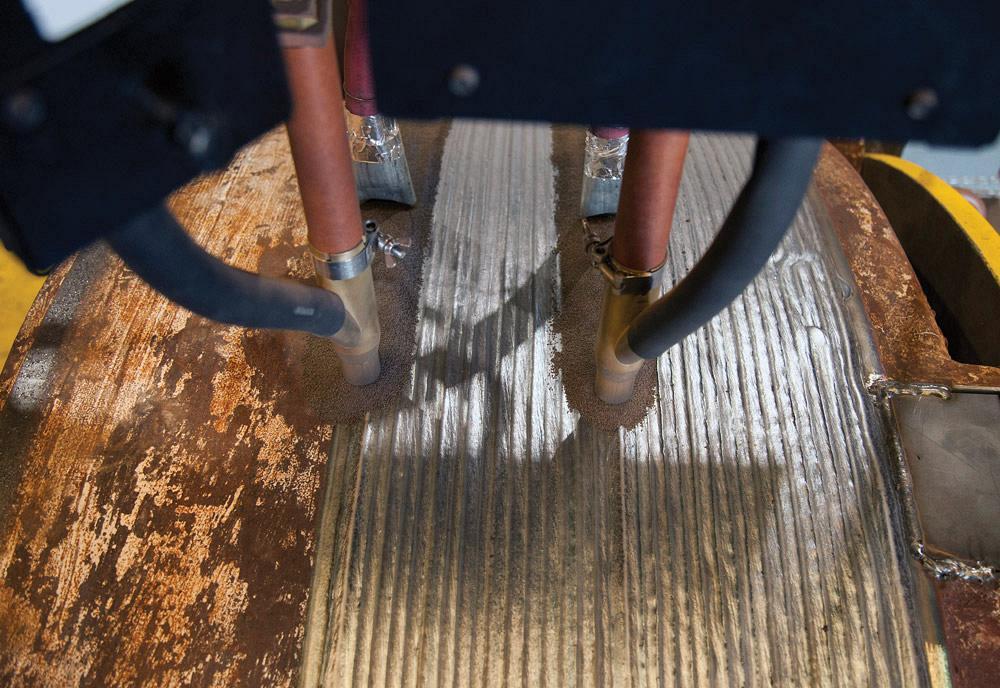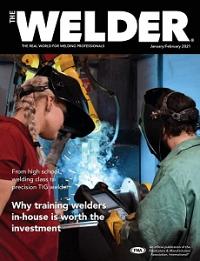Technical Liaison Manager
- FMA
- The Fabricator
- FABTECH
- Canadian Metalworking
Categories
- Additive Manufacturing
- Aluminum Welding
- Arc Welding
- Assembly and Joining
- Automation and Robotics
- Bending and Forming
- Consumables
- Cutting and Weld Prep
- Electric Vehicles
- En Español
- Finishing
- Hydroforming
- Laser Cutting
- Laser Welding
- Machining
- Manufacturing Software
- Materials Handling
- Metals/Materials
- Oxyfuel Cutting
- Plasma Cutting
- Power Tools
- Punching and Other Holemaking
- Roll Forming
- Safety
- Sawing
- Shearing
- Shop Management
- Testing and Measuring
- Tube and Pipe Fabrication
- Tube and Pipe Production
- Waterjet Cutting
Industry Directory
Webcasts
Podcasts
FAB 40
Advertise
Subscribe
Account Login
Search
Consumables Corner: The differentiating factors in SAW flux
- By David Meyer and Rob Koltz
- March 3, 2021
- Article
- Consumables
Q: We are a pressure vessel shop that fabricates carbon steel vessels. Recently we looked into perhaps changing our flux to improve our SAW production. There are several types of flux, and it's a bit confusing on what makes them different and what we are allowed to use for our application. Can you shed some light on this?
A: Yes, we can break it down and hopefully clear up any confusion you may have. Let's start by examining what role flux plays in the submerged arc welding (SAW) process and how it is manufactured and categorized.
SAW flux plays several roles during the welding process. It provides arc enhancers, produces shielding gas, protects the weld from the atmosphere, assists in bead shape, deoxidizes the weld puddle, and some even add alloy to the weld metal.
Flux is manufactured by one of three methods known as fused, agglomerated or bonded, and mechanically mixed. Agglomerated and bonded are used interchangeably to describe the same manufacturing process.
Fused flux has all the raw materials combined, which are then melted down in a high-temperature furnace, cooled to produce a solid, and then ground to small particles. The particle size must fall within the specified range to produce a flux that performs consistently.
A fused flux is very stable at high welding currents; nonhygroscopic so it will not absorb moisture; chemically homogenous, which produces more consistent welds; and has high grain strength so it won’t break down as easily during flux recycling. Flux recycling is the process of recovering the excess flux burden in the weld joint during welding operations, which is different than slag recrushing.
One disadvantage of fused flux is the high temperature used to produce it to prevent metallic deoxidizers from being added to the mixture, so the final product is not favorable for applications involving moderate to high amounts of rust or mill scale.
Bonded (or agglomerated) flux combines all the raw materials to produce a dry mixture that is then bonded by a liquid binder such as potassium silicate or sodium silicate. The mixture is baked at low temperatures and sieved to attain a specified particle size. Bonded fluxes may contain metallic deoxidizers, making them a good option for welding over rust and mill scale, and they might have added alloys to improve weld metal properties. They are also better at preventing porosity than fused flux and are good for slag peeling.
Bonded fluxes have their disadvantages. They are susceptible to moisture absorption, so you should bake it before you use it if the flux is being stored in non-hermetically sealed bags. Also, flux recycling will break down the particles faster than in fused flux, which creates particle fines that need to be filtered out to prevent porosity or pockmarking.
Mechanically mixed flux is simply a combination of ingredients that are dry-mixed with no binder, and their ingredients may include one or more fused or bonded fluxes.
The effect a flux has on the alloy content of the weld is described by the terms active, neutral, and alloying. With an active flux, the manganese and silicon levels in the weld deposit vary significantly with a change in the welding voltages. A neutral flux produces a weld deposit having a consistent amount of Mn and Si over a range of welding voltage. An alloying flux contributes elements other than Mn and Si to the weld deposit, like chromium, molybdenum, and nickel.
Active fluxes typically have additional Mn and Si content that aids in deoxidizing the weld puddle, cleaning impurities, and improving the wetting action. They are better than neutral fluxes for welding over rust and mill scale and can accommodate higher travel speeds. This type of flux is used where there are minimal or no impact requirements. They generally are limited to single-pass welds and not used in heavy-walled pressure vessel applications because the additional Mn paired with high voltages and increased flux consumption elevates the risk for weld cracking.
Neutral flux, much like the name says, will not alter the weld metal chemistry and is allowed in all welding applications and unlimited number of weld passes. This type of flux produces good mechanical properties and cold-weather impact values. However, neutral flux does not perform well over heavy rust and mill scale. Base metal impurities increase the odds of poor weld bead appearance, inconsistent weld toes, and porosity, so performing preweld joint preparation may be necessary.
The industry standard for categorizing flux is through a calculation that produces a number referred to as basicity. There are four major groups within the basicity index: acid, neutral, basic, and highly basic. This calculation produces a range of values between 0.2 and 4.0. A number less than 0.9 is considered acidic; 0.9 to 1.2 is neutral; 1.2 to 2.5 is basic; and 2.5 to 4.0 is highly basic.
Generally, fluxes with higher acidity produce a weld metal with high oxygen content, which makes welding performance very good, but impact toughness is less than ideal. Fluxes having higher basicity produce welds with a lower oxygen content. Highly basic fluxes produce welds with excellent impact toughness but may have less desirable operating characteristics. A neutral flux produces welds with good impact toughness while still having very good welding performance (see Figure 1).
Fused fluxes are acidic, neutral, or slightly basic, whereas agglomerated fluxes may be acidic, neutral, slightly basic, or highly basic.
Neutral and basic fluxes typically are used in applications requiring good impact toughness at low temperatures, such as pressure vessel, bridge and structural, offshore platforms, and large pipe manufacturing.
When determining which flux is best for your application, the first place to look is the welding standard you are working with to see if there are any constraints. Beyond that, choose a wire and flux classification that meets the requirements of the design and/or base materials. Be sure to take into consideration if there is postweld heat treat since some flux/wire combinations will not produce weld metal that meets the requirements. Finally, consider weld joint conditions, like cleanliness, in the joint and along the weld joint edges.
About the Authors


Rob Koltz
Application Engineer
411 S. Ebenezer Rd.
Florence, 29501
636-485-2253
About the Publication
subscribe now

The Welder, formerly known as Practical Welding Today, is a showcase of the real people who make the products we use and work with every day. This magazine has served the welding community in North America well for more than 20 years.
start your free subscription- Stay connected from anywhere

Easily access valuable industry resources now with full access to the digital edition of The Fabricator.

Easily access valuable industry resources now with full access to the digital edition of The Welder.

Easily access valuable industry resources now with full access to the digital edition of The Tube and Pipe Journal.
- Podcasting
- Podcast:
- The Fabricator Podcast
- Published:
- 04/16/2024
- Running Time:
- 63:29
In this episode of The Fabricator Podcast, Caleb Chamberlain, co-founder and CEO of OSH Cut, discusses his company’s...
- Trending Articles
Sheffield Forgemasters makes global leap in welding technology

ESAB unveils Texas facility renovation

Engine-driven welding machines include integrated air compressors

How welders can stay safe during grinding

The impact of sine and square waves in aluminum AC welding, Part I

- Industry Events
16th Annual Safety Conference
- April 30 - May 1, 2024
- Elgin,
Pipe and Tube Conference
- May 21 - 22, 2024
- Omaha, NE
World-Class Roll Forming Workshop
- June 5 - 6, 2024
- Louisville, KY
Advanced Laser Application Workshop
- June 25 - 27, 2024
- Novi, MI




























